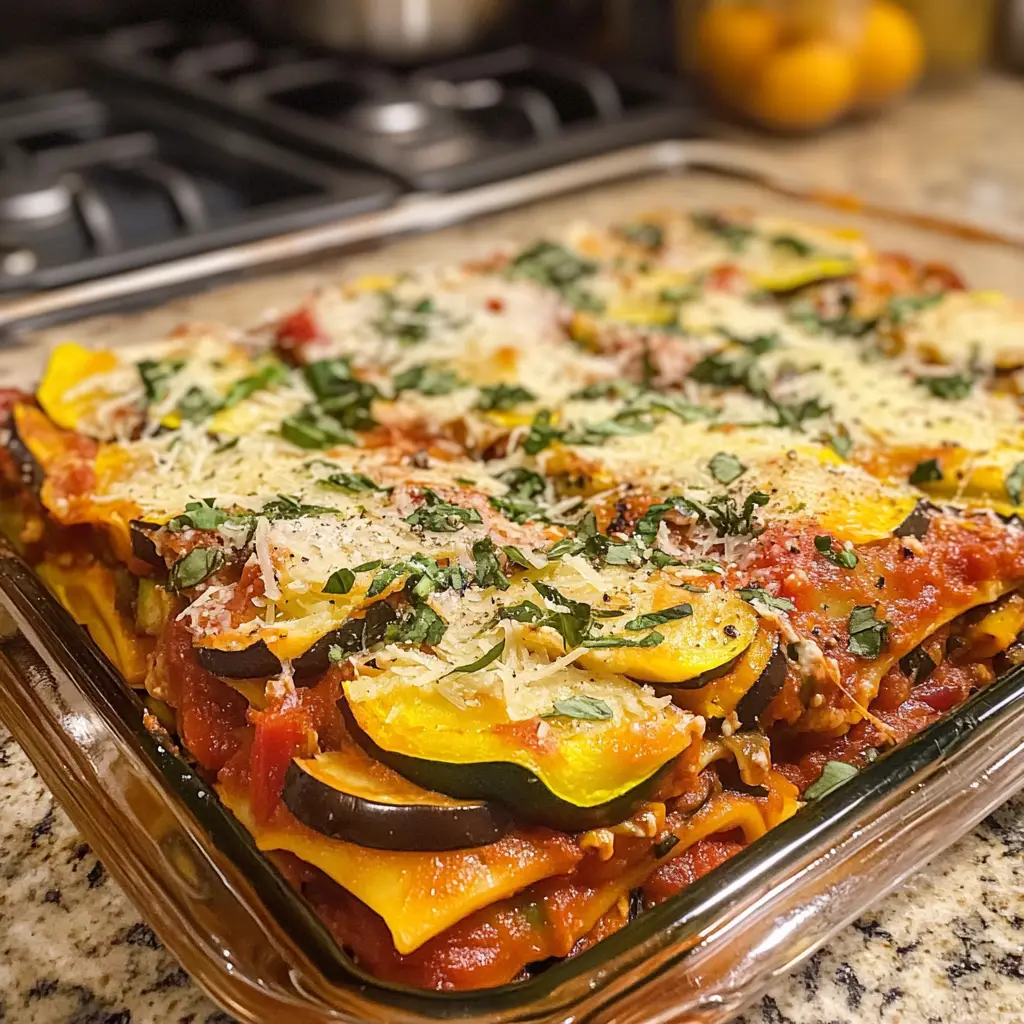Vegetable lasagna is the perfect dish for those who crave the comfort of a classic lasagna but want a lighter, veggie-packed alternative. This dish layers tender roasted vegetables, rich marinara sauce, creamy ricotta, and gooey melted cheese between sheets of pasta, creating a hearty and satisfying meal. Unlike traditional lasagna, which relies on ground meat for its richness, vegetable lasagna gets its depth of flavor from a variety of fresh vegetables, herbs, and a perfectly balanced sauce.
One of the best things about vegetable lasagna is its versatility. You can use any combination of vegetables based on what’s in season or what you have on hand. Zucchini, bell peppers, mushrooms, spinach, and eggplant are some of the most popular choices, but you can experiment with others like broccoli, carrots, or even butternut squash for a unique twist. The layers of vegetables add a naturally sweet and earthy flavor that complements the tangy tomato sauce and creamy cheese filling.
This dish is perfect for both vegetarians and meat-eaters alike. It’s filling enough to be a satisfying main course but light enough to avoid the heaviness that can come with a traditional meat lasagna. Whether you’re making it for a family dinner, a potluck, or meal prepping for the week, vegetable lasagna is a comforting and nourishing choice that never disappoints.
Why You’ll Love This Recipe
There are so many reasons why this vegetable lasagna will become one of your favorite go-to meals. First and foremost, it is absolutely packed with flavor—roasting and sautéing the vegetables enhances their natural sweetness and richness, creating a deep, savory taste that pairs perfectly with the tangy marinara sauce and the creamy, cheesy layers. Every bite is a satisfying combination of textures, from the tender pasta to the melt-in-your-mouth roasted vegetables, making this dish a true comfort food. Beyond its incredible taste, this lasagna is also a powerhouse of nutrition. Loaded with fiber, vitamins, and antioxidants from a variety of fresh vegetables, it provides a nourishing and well-balanced meal that feels indulgent while still being wholesome. Unlike traditional meat-based lasagna, this version is lighter yet just as satisfying, making it a great option for those looking to enjoy a comforting dish without feeling overly full.
One of the best things about this recipe is how perfect it is for meal prep. In fact, it tastes even better the next day, as the flavors continue to meld together, creating an even richer, deeper taste. Whether you’re making it in advance for a busy weeknight dinner or storing leftovers for an easy reheat-and-eat meal, vegetable lasagna is a reliable choice that saves you time while still delivering homemade goodness. Additionally, it’s incredibly versatile—feel free to mix and match your favorite vegetables based on what’s in season or what you have on hand. You can also make simple ingredient swaps to suit different dietary preferences, whether you need a gluten-free, vegan, or low-carb version.
Another reason you’ll love this vegetable lasagna is that it’s the perfect dish for feeding a crowd. Whether you’re serving it at a family dinner, a potluck, or a holiday gathering, it’s always a hit. Its vibrant colors, hearty layers, and irresistible cheesy topping make it a visually appealing and mouthwatering centerpiece for any meal. Even meat-lovers will be impressed by how flavorful and filling this dish is, proving that a vegetarian meal can be just as satisfying as its traditional counterpart. With its delicious taste, health benefits, convenience, and ability to please a crowd, this vegetable lasagna is a recipe you’ll find yourself making again and again.
Ingredients
For the Vegetable Filling:
- 2 tablespoons olive oil
- 1 zucchini, diced
- 1 yellow squash, diced
- 1 red bell pepper, diced
- 1 yellow bell pepper, diced
- 1 small eggplant, diced
- 1 cup mushrooms, sliced
- 3 cloves garlic, minced
- 1 teaspoon salt
- ½ teaspoon black pepper
- 1 teaspoon dried oregano
- ½ teaspoon red pepper flakes (optional, for heat)
- 1 (10-ounce) bag fresh spinach
For the Ricotta Mixture:
- 1 (15-ounce) container ricotta cheese
- 1 cup shredded mozzarella cheese
- ½ cup grated Parmesan cheese
- 1 egg
- 1 teaspoon dried basil
- ½ teaspoon garlic powder
- ½ teaspoon onion powder
For the Sauce and Lasagna Layers:
- 3 cups marinara sauce (store-bought or homemade)
- 12 lasagna noodles, cooked and drained
- 1 ½ cups shredded mozzarella cheese (for topping)
- ½ cup grated Parmesan cheese (for topping)
- 1 tablespoon fresh basil, chopped (for garnish)
Preparation
Step 1: Roast the Vegetables
Preheat your oven to 400°F (200°C). Line a baking sheet with parchment paper. Spread the diced zucchini, squash, bell peppers, eggplant, and mushrooms evenly on the sheet. Drizzle with olive oil and season with salt, pepper, oregano, and red pepper flakes. Toss to coat. Roast in the oven for 20-25 minutes, stirring halfway through, until the vegetables are tender and slightly caramelized.
Step 2: Cook the Spinach
In a large skillet, heat 1 tablespoon of olive oil over medium heat. Add the minced garlic and cook for about 30 seconds until fragrant. Add the fresh spinach and cook, stirring occasionally, until wilted, about 3 minutes. Remove from heat and set aside.
Step 3: Prepare the Ricotta Mixture
In a medium bowl, combine the ricotta cheese, shredded mozzarella, grated Parmesan, egg, dried basil, garlic powder, and onion powder. Mix well until fully combined. Set aside.
Step 4: Cook the Lasagna Noodles
Bring a large pot of salted water to a boil. Cook the lasagna noodles according to the package instructions until al dente. Drain and lay them flat on a baking sheet to prevent sticking.
Step 5: Assemble the Lasagna
Preheat your oven to 375°F (190°C). Spread ½ cup of marinara sauce on the bottom of a 9×13-inch baking dish. Arrange a layer of cooked lasagna noodles on top. Spread ⅓ of the ricotta mixture over the noodles, followed by a layer of roasted vegetables and some sautéed spinach. Pour another ½ cup of marinara sauce over the vegetables. Repeat this layering process two more times, ending with a layer of noodles and the remaining marinara sauce. Sprinkle the top with shredded mozzarella and grated Parmesan cheese.
Step 6: Bake the Lasagna
Cover the baking dish with foil and bake for 30 minutes. Remove the foil and bake for an additional 15 minutes until the cheese is golden and bubbly. Let the lasagna cool for 10-15 minutes before slicing. Garnish with fresh basil before serving.
Variations
1. Vegan Vegetable Lasagna
Replace ricotta cheese with a dairy-free tofu ricotta and use vegan mozzarella for the topping. Use a plant-based egg substitute or omit the egg entirely.
2. Gluten-Free Lasagna
Use gluten-free lasagna noodles or substitute zucchini slices for a low-carb version.
3. Spicy Lasagna
Add 1 teaspoon of crushed red pepper flakes to the marinara sauce for a kick of heat.
4. Mediterranean Lasagna
Incorporate feta cheese, kalamata olives, and sun-dried tomatoes for a Mediterranean twist.
Cooking Notes
- Roasting the vegetables before adding them to the lasagna enhances their natural sweetness and prevents them from releasing excess moisture while baking.
- If you’re using no-boil lasagna noodles, add an extra ½ cup of sauce to ensure they absorb enough moisture.
- Letting the lasagna rest before cutting helps it set and makes slicing easier.
Serving Suggestions
Vegetable lasagna pairs wonderfully with a fresh green salad, garlic bread, or roasted vegetables. A side of creamy tomato soup or a light vinaigrette-based coleslaw complements the rich flavors of the lasagna.
Tips
- Use a mix of colorful vegetables to enhance both the taste and visual appeal.
- Store leftovers in an airtight container in the refrigerator for up to 4 days.
- To freeze, wrap the lasagna tightly in foil and store for up to 3 months. Reheat in the oven at 375°F (190°C) until warmed through.
Prep Time: 30 minutes
Cooking Time: 45 minutes
Total Time: 1 hour 15 minutes
Nutritional Information
Calories: 350 per serving
Protein: 18g
Sodium: 620mg


